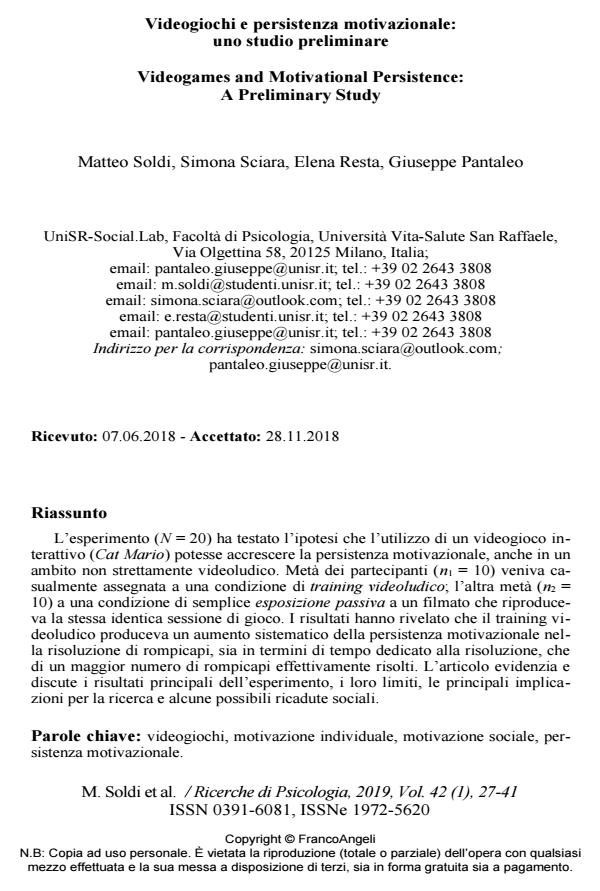Videogiochi e persistenza motivazionale: uno studio preliminare
Titolo Rivista RICERCHE DI PSICOLOGIA
Autori/Curatori Matteo Soldi, Simona Sciara, Elena Resta, Giuseppe Pantaleo
Anno di pubblicazione 2019 Fascicolo 2019/1
Lingua Italiano Numero pagine 15 P. 27-41 Dimensione file 322 KB
DOI 10.3280/RIP2019-001002
Il DOI è il codice a barre della proprietà intellettuale: per saperne di più
clicca qui
Qui sotto puoi vedere in anteprima la prima pagina di questo articolo.
Se questo articolo ti interessa, lo puoi acquistare (e scaricare in formato pdf) seguendo le facili indicazioni per acquistare il download credit. Acquista Download Credits per scaricare questo Articolo in formato PDF

FrancoAngeli è membro della Publishers International Linking Association, Inc (PILA)associazione indipendente e non profit per facilitare (attraverso i servizi tecnologici implementati da CrossRef.org) l’accesso degli studiosi ai contenuti digitali nelle pubblicazioni professionali e scientifiche
L’esperimento (N = 20) ha testato l’ipotesi che l’utilizzo di un videogioco inte-rattivo (Cat Mario) potesse accrescere la persistenza motivazionale, anche in un ambito non strettamente videoludico. Metà dei partecipanti (n1 = 10) veniva ca-sualmente assegnata a una condizione di training videoludico; l’altra metà (n2 = 10) a una condizione di semplice esposizione passiva a un filmato che riprodu-ceva la stessa identica sessione di gioco. I risultati hanno rivelato che il training videoludico produceva un aumento sistematico della persistenza motivazionale nella risoluzione di rompicapi, sia in termini di tempo dedicato alla risoluzione, che di un maggior numero di rompicapi effettivamente risolti. L’articolo eviden-zia e discute i risultati principali dell’esperimento, i loro limiti, le principali impli-cazioni per la ricerca e alcune possibili ricadute sociali.
Parole chiave:Videogiochi, motivazione individuale, motivazione sociale, persistenza motivazionale.
- Handbook of Research on Establishing Digital Competencies in the Pursuit of Online Learning Vincenza Barra, Maria Annarumma, pp.267 (ISBN:9781668470107)
Matteo Soldi, Simona Sciara, Elena Resta, Giuseppe Pantaleo, Videogiochi e persistenza motivazionale: uno studio preliminare in "RICERCHE DI PSICOLOGIA " 1/2019, pp 27-41, DOI: 10.3280/RIP2019-001002